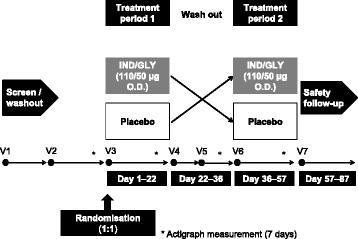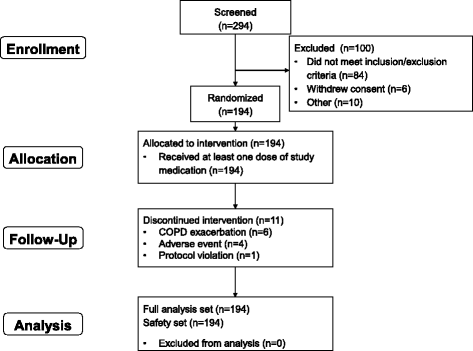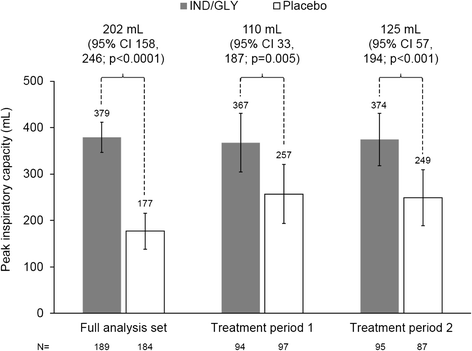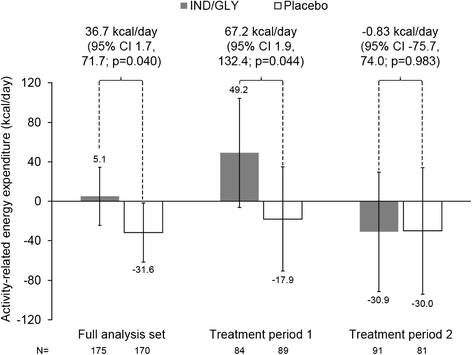Effects of indacaterol/glycopyrronium (QVA149) on lung hyperinflation and physical activity in patients with moderate to severe COPD: a randomised, placebo-controlled, crossover study (The MOVE Study)
- PMID: 27301417
- PMCID: PMC4908762
- DOI: 10.1186/s12890-016-0256-7
Effects of indacaterol/glycopyrronium (QVA149) on lung hyperinflation and physical activity in patients with moderate to severe COPD: a randomised, placebo-controlled, crossover study (The MOVE Study)
Abstract
Background: Physical activity limitation is common in chronic obstructive pulmonary disease (COPD), and is associated with worse health status, and increased hospitalisation and mortality. Long-acting bronchodilators, either alone or in combination, have been shown to improve exercise intolerance. However, none of these studies were designed with physical activity as primary outcome. This study assessed the effect of indacaterol/glycopyrronium fixed dose combination (IND/GLY) 110/50 μg once daily (OD) versus placebo on lung hyperinflation (inspiratory capacity [IC]) and physical activity in patients with moderate-to-severe COPD.
Methods: In this multicentre, randomised, double-blind, placebo-controlled crossover study, patients received IND/GLY or placebo OD in two 21-day treatment periods (14-day washout between periods). Eligible patients were ≥40 years of age, current or ex-smokers (smoking history ≥10 pack-years), with post-salbutamol forced expiratory volume in 1 s (FEV1) 40-80 % predicted, and FEV1:forced vital capacity <0.70. The co-primary endpoints were peak IC after 21 days and average daily activity-related energy expenditure. Key secondary endpoints were average number of steps per day and the duration of at least moderate activity per day. Peak IC and FEV1 on Day 1, and trough IC and FEV1 after 21 days were other secondary endpoints.
Results: A total of 194 patients were randomised (65.5 % male, mean age 62.8 years, mean FEV1 61.6 % predicted), with 183 (94.3 %) completing the study. Compared with placebo, IND/GLY significantly increased peak IC after 21 days (difference 202 mL, p < 0.0001), activity-related energy expenditure (difference 36.7 kcal/day, p = 0.040), and the average number of steps per day (difference 358, p = 0.029), with a trend towards an improvement in the duration of at least moderate activity (difference 4.4 min, p = 0.264). IND/GLY was associated with statistically significant improvements versus placebo in peak IC and FEV1 on Day 1, and trough IC and FEV1 after 21 days. The incidence of treatment-emergent adverse events was 22.8 % with IND/GLY and 22.9 % with placebo.
Conclusions: In this study, compared with placebo, IND/GLY reduced hyperinflation, and, despite no patient education or lifestyle advice, improved daily physical activity levels. This suggests that IND/GLY has the potential to impact two of the main clinical concerns in the care of patients with COPD.
Trial registration: ClinicalTrials.gov number: NCT01996319 .
Keywords: Bronchodilator; COPD; Hyperinflation; Physical activity.
Figures




References
-
- Watz H, Pitta F, Rochester CL, Garcia-Aymerich J, ZuWallack R, Troosters T, Vaes AW, Puhan MA, Jehn M, Polkey MI, Vogiatzis I, Clini EM, Toth M, Gimeno-Santos E, Waschki B, Esteban C, Hayot M, Casaburi R, Porszasz J, McAuley E, Singh SJ, Langer D, Wouters EFM, Magnussen H, Spruit MA. An official European Respiratory Society statement on physical activity in COPD. Eur Respir J. 2014;44:1521–37. doi: 10.1183/09031936.00046814. - DOI - PubMed
-
- Waschki B, Kirsten AM, Holz O, Mueller K-C, Schaper M, Sack A-L, Meyer T, Rabe KF, Magnussen H, Watz H. Disease progression and changes in physical activity in patients with chronic obstructive pulmonary disease. Am J Respir Crit Care Med. 2015;192:295–306. doi: 10.1164/rccm.201501-0081OC. - DOI - PubMed
Publication types
MeSH terms
Substances
Associated data
LinkOut - more resources
Full Text Sources
Other Literature Sources
Medical

